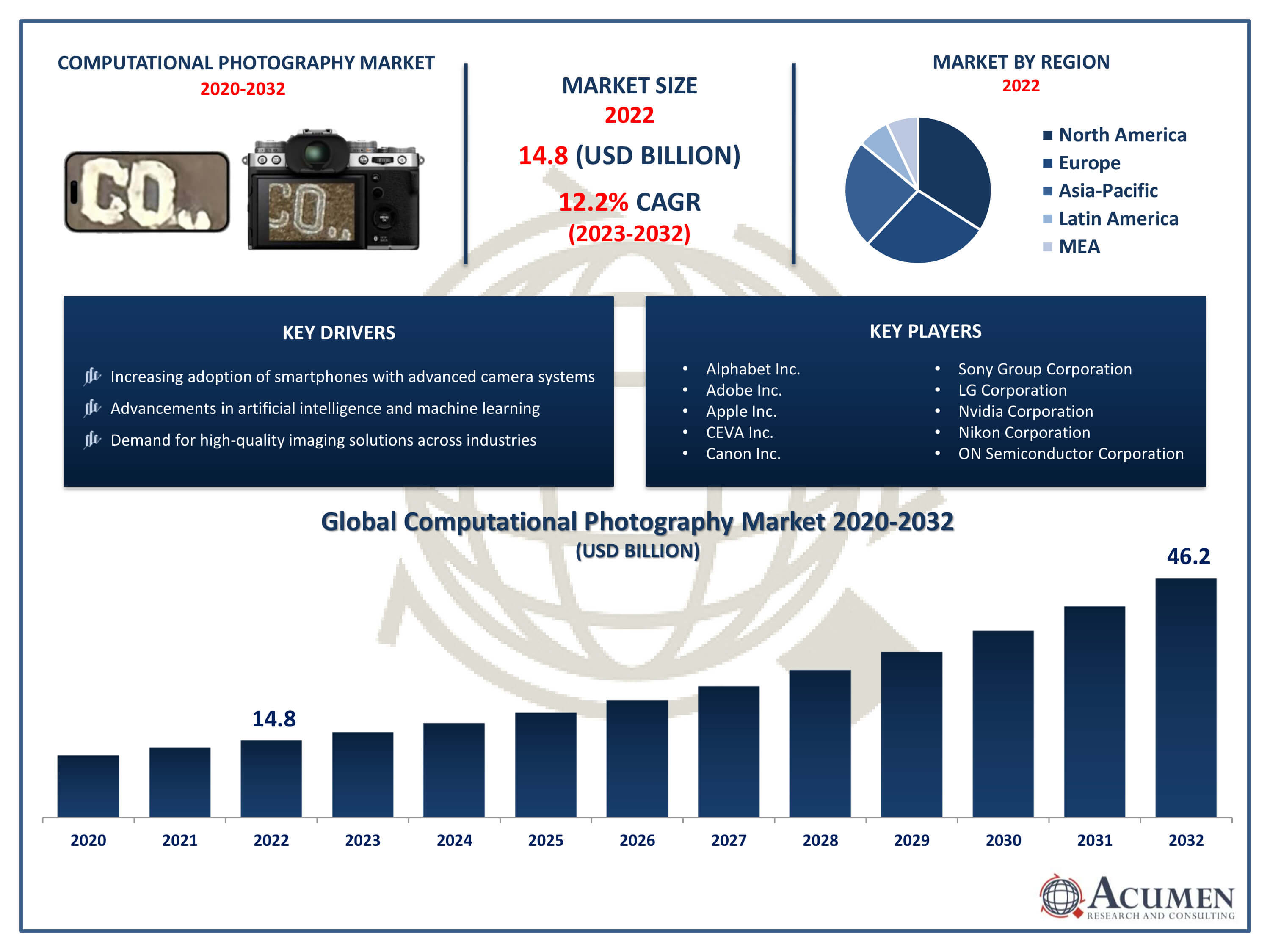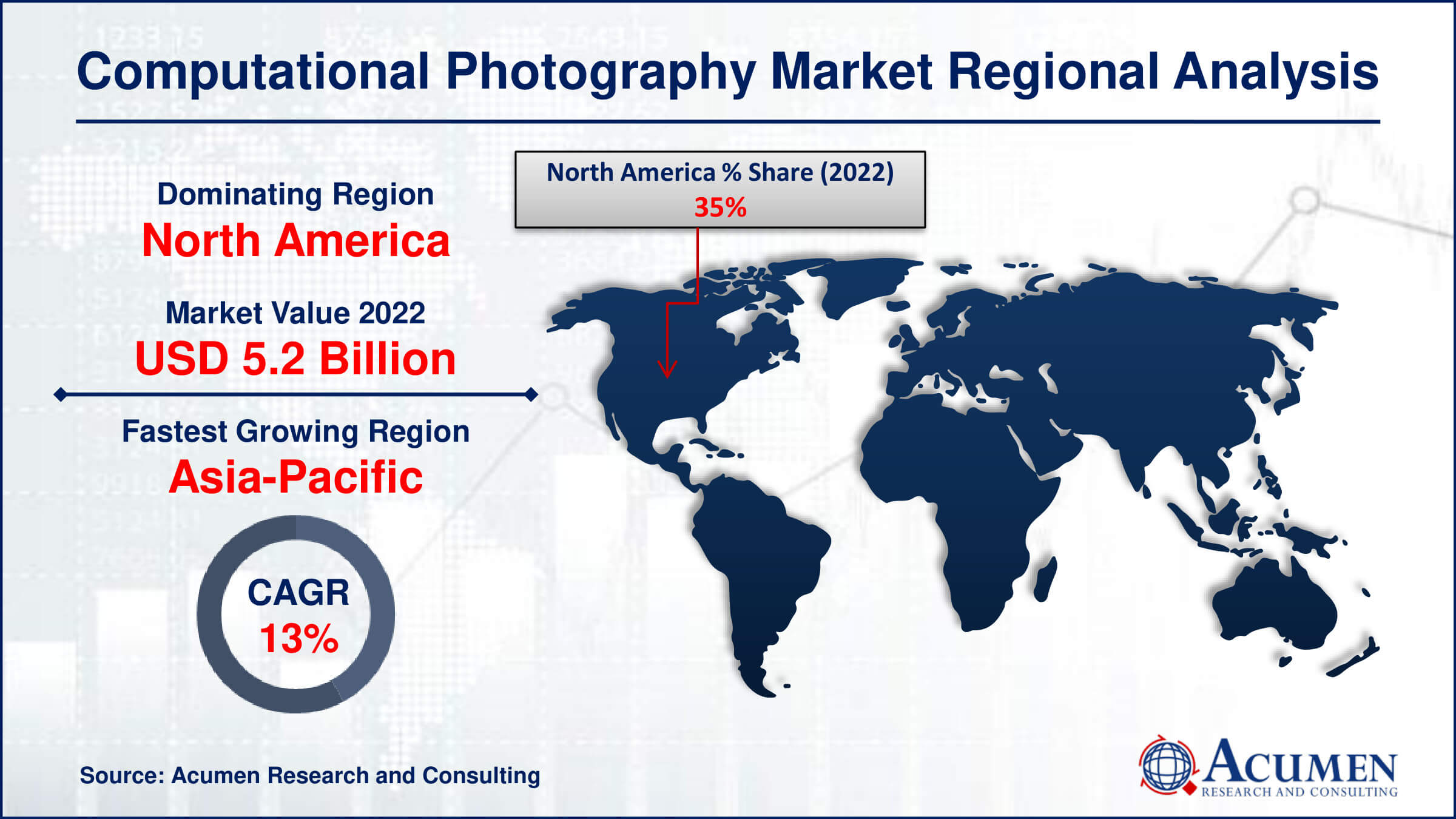Computational Photography Market Size - Global Industry, Share, Analysis, Trends and Forecast 2023 - 2032
Published :
Report ID:
Pages :
Format :
Computational Photography Market Size - Global Industry, Share, Analysis, Trends and Forecast 2023 - 2032
Report Coverage
- Industry Dynamics
- Market Size and Forecast Data
- Segment Analysis
- Competitive Landscape
- Regional Analysis with a Niche Focus on Country-Level Data
- High Level Analysis - Porter's, PESTEL, Value Chain, etc.
- Company Profiles of Key Players
- Option to Customize the Report As Per Your Specific Need
Request Sample Report
The Computational Photography Market Size accounted for USD 14.8 Billion in 2022 and is projected to achieve a market size of USD 46.2 Billion by 2032 growing at a CAGR of 12.2% from 2023 to 2032.
Computational Photography Market Highlights
- Global computational photography market revenue is expected to increase by USD 46.2 Billion by 2032, with a 12.2% CAGR from 2023 to 2032
- North America region led with more than 35% of computational photography market share in 2022
- Asia-Pacific computational photography market growth will record a CAGR of more than 13.4% from 2023 to 2032
- By product, the smartphone cameras segment captured more than 50% of revenue share in 2022.
- By application, the 3D imaging segment is projected to expand at the fastest CAGR over the projected period
- Increasing adoption of smartphones with advanced camera systems, drives the computational photography market value

Computational photography is a field that combines traditional photography techniques with computational imaging methods to enhance or enable new capabilities in digital photography. It involves using algorithms and software to process images captured by digital cameras or smartphones, often in real-time. This approach allows for a wide range of enhancements such as improved low-light performance, enhanced dynamic range, depth mapping for portrait effects, image stabilization, and more.
The market for computational photography has experienced significant growth in recent years, driven by the increasing adoption of smartphones equipped with advanced camera systems and the demand for high-quality imaging solutions. Additionally, advancements in artificial intelligence and machine learning have fueled innovation in computational photography techniques, enabling more sophisticated image processing algorithms. The market encompasses not only consumer electronics but also applications in industries such as healthcare, automotive, security, and augmented reality/virtual reality (AR/VR), where imaging technologies play a crucial role.
Global Computational Photography Market Trends
Market Drivers
- Increasing adoption of smartphones with advanced camera systems
- Advancements in artificial intelligence and machine learning
- Demand for high-quality imaging solutions across industries
- Proliferation of multi-camera setups in smartphones
- Integration of computational photography features into standalone cameras
Market Restraints
- Privacy and ethical concerns regarding image processing
- Compatibility issues with legacy hardware and software
Market Opportunities
- Growing applications in healthcare, automotive, security, and AR/VR
- Expansion of imaging solutions for autonomous vehicles
Computational Photography Market Report Coverage
| Market | Computational Photography Market |
| Computational Photography Market Size 2022 | USD 14.8 Billion |
| Computational Photography Market Forecast 2032 |
USD 46.2 Billion |
| Computational Photography Market CAGR During 2023 - 2032 | 12.2% |
| Computational Photography Market Analysis Period | 2020 - 2032 |
| Computational Photography Market Base Year |
2022 |
| Computational Photography Market Forecast Data | 2023 - 2032 |
| Segments Covered | By Product, By Offering, By Application, And By Geography |
| Regional Scope | North America, Europe, Asia Pacific, Latin America, and Middle East & Africa |
| Key Companies Profiled | Alphabet Inc., Adobe Inc., Apple Inc., CEVA Inc., Canon Inc., Sony Group Corporation, LG Corporation, Nvidia Corporation, Nikon Corporation, ON Semiconductor Corporation, Samsung Electronics Co. Ltd., and Qualcomm Technologies Inc. |
| Report Coverage |
Market Trends, Drivers, Restraints, Competitive Analysis, Player Profiling, Covid-19 Analysis, Regulation Analysis |
Computational photography is a revolutionary approach to capturing and processing images that leverages advanced algorithms and computational techniques to enhance or enable new capabilities in digital photography. Unlike traditional photography, which relies solely on optical hardware, computational photography utilizes software-driven methods to improve image quality, manipulate scenes, and create novel visual effects. This field encompasses a wide range of techniques, including image fusion, image stacking, HDR (High Dynamic Range), depth mapping, and image stabilization, among others. The applications of computational photography span various industries and domains. In the realm of consumer electronics, smartphones equipped with sophisticated computational photography features have become increasingly popular. These features enable users to capture high-quality images even in challenging lighting conditions, apply portrait mode effects, and create stunning panoramas. Computational photography also plays a vital role in fields such as healthcare, where it is used for medical imaging applications like CT scans, MRI, and microscopy, enhancing diagnostic accuracy and enabling new imaging modalities.
The computational photography market has witnessed remarkable growth in recent years, fueled by technological advancements and increasing demand for high-quality imaging solutions. With the proliferation of smartphones equipped with advanced camera systems, consumers are becoming more accustomed to features such as portrait mode, night mode, and enhanced image stabilization, all made possible through computational photography techniques. Additionally, the integration of artificial intelligence and machine learning algorithms has enabled more sophisticated image processing, further enhancing the capabilities of digital cameras and smartphones. Factors such as the rising popularity of social media platforms, where high-quality images play a crucial role, are driving the demand for advanced imaging solutions. Moreover, the increasing use of computational photography techniques in various industries such as healthcare, automotive, and augmented reality/virtual reality (AR/VR) is creating new opportunities for market expansion.
Computational Photography Market Segmentation
The global computational photography market segmentation is based on product, offering, application, and geography.
Computational Photography Market By Product
- Smartphone cameras
- Machine vision cameras
- Standalone cameras
According to the computational photography industry analysis, the smartphone cameras segment accounted for the largest market share in 2022. As smartphones have become the primary device for capturing photos and videos for many consumers, there's a growing emphasis on improving the capabilities of their built-in cameras. This trend has led to the integration of advanced computational photography features in smartphones, such as multi-camera setups, AI-driven scene recognition, night mode, and portrait mode. These features leverage sophisticated algorithms to enhance image quality, optimize exposure, and create stunning visual effects, leading to a more immersive and satisfying photography experience for users. Furthermore, the increasing competition among smartphone manufacturers to differentiate their products has fueled innovation in computational photography. Companies are investing heavily in research and development to push the boundaries of what smartphone cameras can achieve, resulting in a continuous stream of new features and improvements.
Computational Photography Market By Offering
- Software
- Camera modules
In terms of offerings, the camera modules segment is expected to witness significant growth in the coming years. This growth is driven by increasing demand for high-performance imaging solutions across various industries. Camera modules, which encompass both standalone cameras and those integrated into devices such as smartphones, tablets, and laptops, are incorporating advanced computational photography features to enhance image quality and functionality. This trend is particularly evident in the development of multi-camera setups, which leverage computational algorithms to enable features such as depth mapping, portrait mode, and enhanced low-light performance. Furthermore, the integration of artificial intelligence and machine learning technologies into camera modules is driving innovation in computational photography. These technologies enable real-time image processing and analysis, allowing for advanced functionalities such as scene recognition, object tracking, and image enhancement.
Computational Photography Market By Application
- 3D imaging
- Augmented reality
- Virtual reality
- Mixed reality
According to the computational photography market forecast, the 3D imaging segment is expected to witness significant growth in the coming years. This growth is driven by increasing demand for immersive and interactive visual experiences across various industries. 3D imaging techniques, enabled by computational photography algorithms, allow for the capture and rendering of three-dimensional scenes with depth information. This technology is being utilized in applications such as virtual reality (VR), augmented reality (AR), gaming, automotive, healthcare, and industrial automation, among others. With the proliferation of 3D-enabled devices and the growing popularity of immersive media, the demand for advanced 3D imaging solutions is on the rise. Advancements in computational photography algorithms, coupled with improvements in hardware technology, are driving innovation in the 3D imaging segment. Techniques such as structured light, time-of-flight (ToF) sensing, and stereo vision are being integrated into camera systems to capture depth information accurately and efficiently.
Computational Photography Market Regional Outlook
North America
- U.S.
- Canada
Europe
- U.K.
- Germany
- France
- Spain
- Rest of Europe
Asia-Pacific
- India
- Japan
- China
- Australia
- South Korea
- Rest of Asia-Pacific
Latin America
- Brazil
- Mexico
- Rest of Latin America
The Middle East & Africa
- South Africa
- GCC Countries
- Rest of the Middle East & Africa (ME&A)

Computational Photography Market Regional Analysis
North America asserts dominance in the computational photography market owing to several key factors. North America is home to a plethora of leading technology companies and research institutions at the forefront of innovation in imaging technology. Companies like Google, Apple, and Adobe, among others, have heavily invested in developing advanced computational photography algorithms and integrating them into their products, driving market growth. Additionally, North America boasts a large consumer base with a high demand for cutting-edge imaging solutions, particularly in the rapidly evolving smartphone market. Moreover, North America benefits from a robust ecosystem supporting technological innovation, including access to venture capital, strong intellectual property protections, and a culture of entrepreneurship. These factors create a conducive environment for startups and tech companies to develop and commercialize novel computational photography technologies. Furthermore, the region's leadership in industries such as entertainment, healthcare, and automotive drives demand for innovative imaging solutions across various sectors, further solidifying its position as a dominant player in the computational photography market. Overall, North America's technological prowess, innovation ecosystem, and substantial consumer base position it as a leader in driving the growth and development of the computational photography market.
Computational Photography Market Player
Some of the top computational photography market companies offered in the professional report include Alphabet Inc., Adobe Inc., Apple Inc., CEVA Inc., Canon Inc., Sony Group Corporation, LG Corporation, Nvidia Corporation, Nikon Corporation, ON Semiconductor Corporation, Samsung Electronics Co. Ltd., and Qualcomm Technologies Inc.
Frequently Asked Questions
How big is the computational photography market?
The computational photography market size was USD 14.8 Billion in 2022.
What is the CAGR of the global computational photography market from 2023 to 2032?
The CAGR of computational photography is 12.2% during the analysis period of 2023 to 2032.
Which are the key players in the computational photography market?
The key players operating in the global market are including Alphabet Inc., Adobe Inc., Apple Inc., CEVA Inc., Canon Inc., Sony Group Corporation, LG Corporation, Nvidia Corporation, Nikon Corporation, ON Semiconductor Corporation, Samsung Electronics Co. Ltd., and Qualcomm Technologies Inc.
Which region dominated the global computational photography market share?
North America held the dominating position in computational photography industry during the analysis period of 2023 to 2032.
Which region registered fastest CAGR from 2023 to 2032?
Asia-Pacific region exhibited fastest growing CAGR for market of computational photography during the analysis period of 2023 to 2032.
What are the current trends and dynamics in the global computational photography industry?
The current trends and dynamics in the computational photography industry include increasing adoption of smartphones with advanced camera systems, advancements in artificial intelligence and machine learning, and demand for high-quality imaging solutions across industries.
Which product held the maximum share in 2022?
The smartphone cameras product held the maximum share of the computational photography industry.


